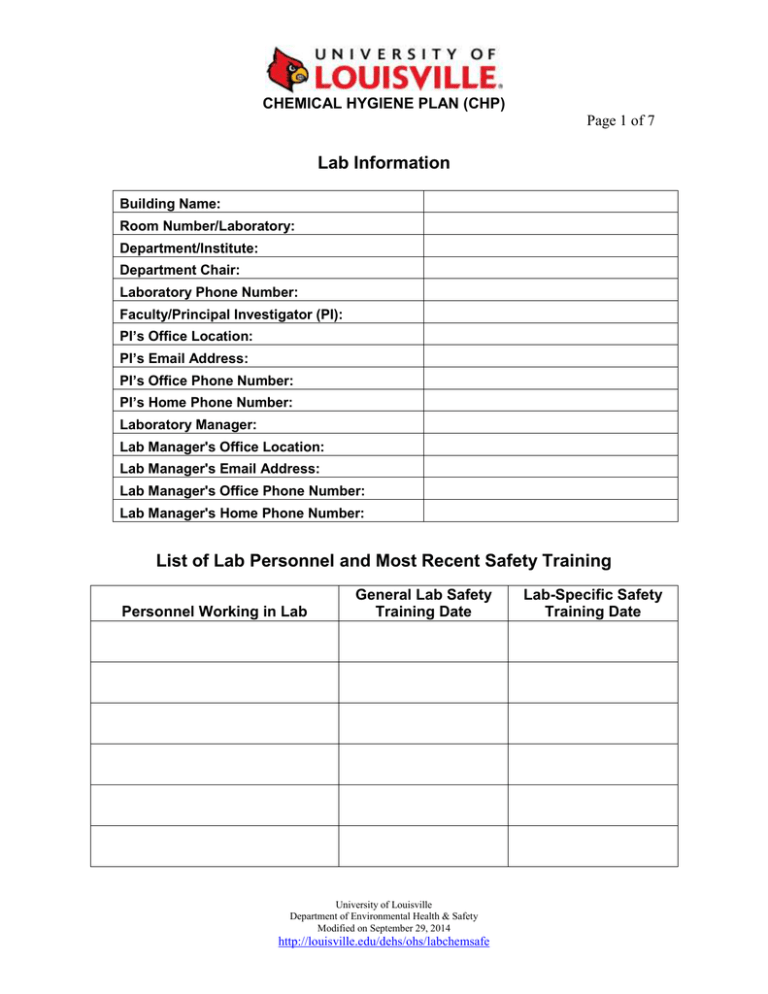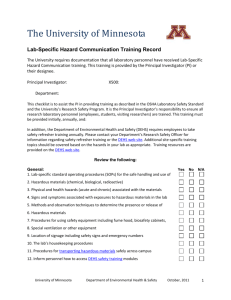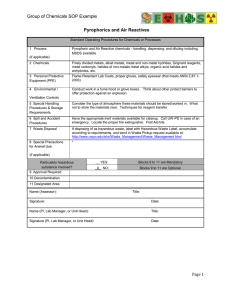Lab Information CHEMICAL HYGIENE PLAN (CHP) Page 1 of 7
advertisement

CHEMICAL HYGIENE PLAN (CHP) Page 1 of 7 Lab Information Building Name: Room Number/Laboratory: Department/Institute: Department Chair: Laboratory Phone Number: Faculty/Principal Investigator (PI): PI’s Office Location: PI’s Email Address: PI’s Office Phone Number: PI’s Home Phone Number: Laboratory Manager: Lab Manager's Office Location: Lab Manager's Email Address: Lab Manager's Office Phone Number: Lab Manager's Home Phone Number: List of Lab Personnel and Most Recent Safety Training Personnel Working in Lab General Lab Safety Training Date University of Louisville Department of Environmental Health & Safety Modified on September 29, 2014 http://louisville.edu/dehs/ohs/labchemsafe Lab-Specific Safety Training Date CHEMICAL HYGIENE PLAN (CHP) Page 2 of 7 Initial Date of CHP Preparation: Date Revised: Revised By: The CHP must be reviewed annually. Laboratory Chemical Hygiene Plan Scope This program applies to all laboratory personnel who work with hazardous chemicals. The emphasis of this document is to address the unique hazards of individual lab units. These lab-specific procedures, when combined with the Chemical Safety Section of the Laboratory Safety Manual comprise a comprehensive Chemical Hygiene Plan designed to protect lab personnel from the health hazards of chemicals used in the laboratory. Administrative Responsibilities The University of Louisville is responsible for ensuring the safety of its employees and for complying with all related requirements of state and federal regulations. Because of the importance the university places on safety, the administration encourages employees at all levels to promote positive attitudes regarding safety, to incorporate safety into their work practices, and to cooperate fully in the implementation of safety-related programs. Faculty/Principal Investigator The Faculty/Principal Investigator is charged with adapting and implementing a lab-specific Chemical Hygiene Plan (CHP). This includes maintaining a chemical inventory, ensuring access to material safety data sheets, developing written standard operating procedures (SOP’s) for use of highly hazardous chemicals, enforcing safety practices, providing or scheduling employee training, and reporting hazardous conditions to the University CHO. The supervisor must also review the lab-specific SOP’s and Chemical Hygiene Plan annually and update the documents as necessary. University of Louisville Department of Environmental Health & Safety Modified on September 29, 2014 http://louisville.edu/dehs/ohs/labchemsafe CHEMICAL HYGIENE PLAN (CHP) Page 3 of 7 The first time you customize your Chemical Hygiene Plan and Chemical Inventory, send a copy to the DEHS Lab Safety Coordinator. Electronic submission is preferred, but a printed copy is also acceptable. Laboratory Personnel Laboratory personnel are responsible for observing all appropriate practices and procedures contained in the Chemical Hygiene Plan as well as other general safety practices, for attending designated training sessions, and for reporting hazardous or unsafe conditions to the PI or DEHS Lab Safety Coordinator. Any deviation from procedures involving hazardous chemicals requires prior approval. DEHS The specific responsibility for developing and assisting in the implementation of U of L programs for health and safety in laboratories resides with the Department of Environmental Health and Safety (DEHS). The DEHS Laboratory Safety Coordinator, who is designated as the University Chemical Hygiene Officer, performs the lead role in this effort. The DEHS Lab Safety Coordinator will perform periodic lab safety audits, conduct General Laboratory Safety Training and provide technical guidance in development and implementation of labspecific Chemical Hygiene Plans. Internal Lab Responsibilities Describe any additional responsibilities lab personnel have pertaining to health and safety. This may include maintaining chemical inventories, SDS’s and training records, preparation of SOP’s, etc. General Laboratory Safety Rules Safety must be thought about, acted upon, and encouraged until it becomes a habit for all workers. Every laboratory worker shall observe the guidelines in the General Safety Section of the Lab Safety Manual. Operations/Procedures Requiring Prior Approval University of Louisville Department of Environmental Health & Safety Modified on September 29, 2014 http://louisville.edu/dehs/ohs/labchemsafe CHEMICAL HYGIENE PLAN (CHP) Page 4 of 7 Prior approval of the Faculty/Principal Investigator is required for certain operations such as working alone after hours and for leaving experiments or equipment running unattended after hours. Other procedures requiring prior approval include: Ordering and Storing Chemicals The general procedure Ordering and Storing Chemicals in the Chemical Safety Section of the Lab Safety Manual contains information concerning the ordering, use and storage of hazardous chemicals, and discusses labeling requirements for chemical containers. The general procedure Flammables and Combustibles in the Chemical Safety section of the Lab Safety Manual provides guidance regarding storage of flammable and combustible liquids. Chemical Inventory The Faculty/Principal Investigator is responsible for ensuring maintenance of an accurate and current chemical inventory. Chemical Inventory Criteria discusses the type of chemicals required to be included in the chemical inventory. A chemical inventory template in Microsoft Excel is also provided. Other formats are acceptable as long as they contain the same information. The first time you customize your Chemical Hygiene Plan and Chemical Inventory, send a copy to the DEHS Lab Safety Coordinator. Electronic submission is preferred, but a printed copy is also acceptable. Safety Data Sheets (SDS) Prior to using any chemicals, laboratory personnel will make sure they are aware of the health risks, chemical reactivity, and safe handling practices. The SDS can be a ready source of this information. SDS’s accompany shipments of chemicals, or can be obtained from the manufacturer/supplier of the chemical. The DEHS SDS web page has links to the web sites of several chemical vendors widely used at U of L. An SDS for each hazardous chemical must be available in the lab or department. The SDS must be readily accessible to all lab personnel during working hours. SDS’s may be maintained as hard copies in an organized fashion such as a University of Louisville Department of Environmental Health & Safety Modified on September 29, 2014 http://louisville.edu/dehs/ohs/labchemsafe CHEMICAL HYGIENE PLAN (CHP) Page 5 of 7 binder, or may be accessed through a bookmarked Internet site. If the Internet is used, each person in the lab who uses chemicals must be registered, if required by the site, and trained to use the site to access and print an SDS. Describe the location of SDS access below: Safe Operating Procedures for Highly Hazardous Chemicals Lab-specific SOP’s providing detailed information relevant to safety and health considerations are required when laboratory work involves the use of highly hazardous chemicals (refer to highly hazardous chemicals in the chemical safety section of the lab safety manual) as defined by OSHA. Consideration must be given to disposing of highly hazardous chemicals that are stored in the lab but are not in active use. The section Hazard Control for Highly Hazardous Chemicals in the Chemical Safety Section of the lab safety manual can assist the Faculty/Principal Investigator in developing the special procedures required to minimize the risks posed by these chemicals. Individual lab units will need to develop their own lab-specific SOP’s and training for highly hazardous chemicals unique to their research/activities. Some laboratories already have these SOP’s in place, while others will have to develop them. Written Safety Procedures – SOP’s and SASP’s provides guidelines and a template for developing SOP’s relevant to safety and health considerations are p. The customized written SOP’s are an integral part of an individual lab unit’s Chemical Hygiene Plan and must be kept on file with this document. If work involves the use of hazardous drugs or chemicals, a Special Animal Safety Protocol (SASP) is required. Control Measures The General Rules for Handling of Chemicals in the Chemical Safety Section of the lab safety manual discusses laboratory chemical hoods, personal protective equipment (PPE) and other control measures. The OSHA PPE Hazard Assessment for Laboratories prescribes appropriate PPE for general lab operations and must be printed out and posted in the laboratory. Individual SOP’s for highly hazardous chemicals shall address control measures in detail. The DEHS Lab Safety Coordinator is available to test the effectiveness of controls and may perform air monitoring if conditions warrant. University of Louisville Department of Environmental Health & Safety Modified on September 29, 2014 http://louisville.edu/dehs/ohs/labchemsafe CHEMICAL HYGIENE PLAN (CHP) Page 6 of 7 Injuries / Chemical Exposures The DEHS web page Injuries and Illnesses provides information on obtaining medical care if you become ill or injured while at work as well as the reporting requirements for work-related illnesses and injuries. After first aid has been administered and medical follow-up occurs, report all lab-related accidents and chemical exposures to the DEHS Lab Safety Coordinator for investigation. Requirements for Medical Consultations and Examinations are defined by the OSHA Lab Standard. Describe below the specific procedures for laboratory personnel to follow when reporting an injury/chemical exposure: Spills Spills of toxic substances must be resolved immediately. Spill response must be part of every Safe Operating Procedure. Planning for Chemical Spills describes a procedure to ensure effective preplanning for spill response. Waste Disposal When hazardous materials become outdated, unstable or are no longer of use to the laboratory, the Faculty/Principal Investigator is responsible for the proper disposal of the chemicals. After disposal the item must be deleted from the chemical inventory list. For complete information regarding chemical waste disposal refer to the DEHS Waste Disposal Guide. Vacating or Renovating a Laboratory Prior to vacating or renovating a laboratory space, the Faculty/Principal Investigator is responsible for ensuring completion of Laboratory Close-Out Procedures. Training University of Louisville Department of Environmental Health & Safety Modified on September 29, 2014 http://louisville.edu/dehs/ohs/labchemsafe CHEMICAL HYGIENE PLAN (CHP) Page 7 of 7 All personnel who work in laboratories are required to receive general lab safety training as well as lab-specific training. The DEHS Lab Safety Coordinator conducts General Laboratory Safety Training that covers requirements of the OSHA Lab Standard, as well as general lab safety rules. The Faculty/Principal Investigator is responsible for providing Lab-Specific Training to all lab personnel. This training is based on the contents of the lab specific Chemical Hygiene Plan, including SOP’s for highly hazardous chemicals. Record Keeping Permanent records are maintained by DEHS of: o Environmental monitoring done to determine the presence and concentration of hazardous substances in laboratories. o Chemical hood performance in laboratories. o Results of accident investigations and recommendations for actions to minimize the risk of recurrence. Copies of the sign-in sheets from General Lab Safety Training are sent to the Office of Research Integrity who maintains the data in their electronic database of compliance training, which may be accessed via Crystal Reports. The following records are maintained by the Faculty/Principal Investigator for each lab: o An up-to-date, accurate Chemical Hygiene Plan o Training records for lab-specific training which include employee signatures o SDS’s for all hazardous chemicals currently stored in the laboratory o The inventory of hazardous chemicals stored in the laboratory o SOP’s for Highly Hazardous Chemicals currently in use in the laboratory o Special Animal Safety Protocols (SASPs) for work with Hazardous Drugs or Chemicals. University of Louisville Department of Environmental Health & Safety Modified on September 29, 2014 http://louisville.edu/dehs/ohs/labchemsafe


